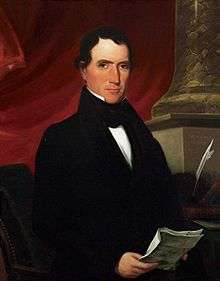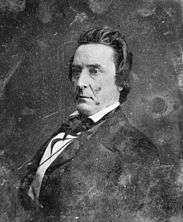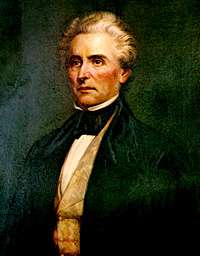32nd United States Congress
| 32nd United States Congress | |||||||||||||||||||||||||||||
| |||||||||||||||||||||||||||||
The Thirty-second United States Congress was a meeting of the legislative branch of the United States federal government, consisting of the United States Senate and the United States House of Representatives. It met in Washington, D.C. from March 4, 1851 to March 4, 1853, during the third and fourth years of Millard Fillmore's presidency. The apportionment of seats in the House of Representatives was based on the Sixth Census of the United States in 1840. Both chambers had a Democratic majority.
Major events

- March 20, 1852: Uncle Tom's Cabin published
- July 1, 1852: Henry Clay was the first to lie in state in the United States Capitol rotunda
- November 2, 1852: U.S. presidential election, 1852: Democrat Franklin Pierce defeated Whig Winfield Scott
Major legislation
- [Data unknown/missing. You can help!]
Territories organized
- March 2, 1853: Washington Territory was formed from Oregon Territory.
Party summary
Senate
| Party (shading shows control) |
Total | Vacant | |||
|---|---|---|---|---|---|
| Democratic (D) |
Free Soil (FS) | Whig (W) | |||
| End of the previous congress | 36 | 2 | 24 | 62 | 0 |
| Begin | 34 | 2 | 21 | 57 | 5 |
| End | 35 | 3 | 23 | 61 | 1 |
| Final voting share | 57.4% | 4.9% | 37.7% | ||
| Beginning of the next congress | 36 | 3 | 22 | 61 | 2 |
House of Representatives
| Party (Shading indicates majority caucus) |
Total | Vacant | ||||||||||||||||||||||||||||||||||||||||||||||||||||||||||||||||||||||||||||||||||||||||||||||||
|---|---|---|---|---|---|---|---|---|---|---|---|---|---|---|---|---|---|---|---|---|---|---|---|---|---|---|---|---|---|---|---|---|---|---|---|---|---|---|---|---|---|---|---|---|---|---|---|---|---|---|---|---|---|---|---|---|---|---|---|---|---|---|---|---|---|---|---|---|---|---|---|---|---|---|---|---|---|---|---|---|---|---|---|---|---|---|---|---|---|---|---|---|---|---|---|---|---|---|
| Democratic (D) |
Independent Democratic (ID) |
Free Soil (FS) |
States' Rights (SR) |
Constitutional Unionist (CU) |
Whig (W) |
Independent Whig (IW) |
Other | |||||||||||||||||||||||||||||||||||||||||||||||||||||||||||||||||||||||||||||||||||||||||||
| End of previous Congress | 113 | 0 | 9 | 0 | 0 | 107 | 0 | 2 | 231 | 2 | ||||||||||||||||||||||||||||||||||||||||||||||||||||||||||||||||||||||||||||||||||||||||
| Begin | 130 | 3 | 3 | 3 | 10 | 85 | 1 | 0 | 235 | 0 | ||||||||||||||||||||||||||||||||||||||||||||||||||||||||||||||||||||||||||||||||||||||||
| End | 128 | 86 | 234 | 1 | ||||||||||||||||||||||||||||||||||||||||||||||||||||||||||||||||||||||||||||||||||||||||||||||
| Final voting share | 54.7% | 1.3% | 1.3% | 1.3% | 4.3% | 36.8% | 0.4% | 0.0% | ||||||||||||||||||||||||||||||||||||||||||||||||||||||||||||||||||||||||||||||||||||||||||
| Beginning of next Congress | 158 | 1 | 3 | 0 | 0 | 71 | 0 | 1 | 234 | 0 | ||||||||||||||||||||||||||||||||||||||||||||||||||||||||||||||||||||||||||||||||||||||||
Leadership

(until December 20, 1852)

(from December 20, 1852)
Senate
- President: Vacant (since the ascension of Millard Fillmore to U.S. President on July 9, 1850)
- President pro tempore: William R. King (D), until December 20, 1852
- David R. Atchison (D), from December 20, 1852
House of Representatives
Members
This list is arranged by chamber, then by state. Senators are listed in order of seniority, and Representatives are listed by district.
Senate
Senators were elected by the state legislatures every two years, with one-third beginning new six-year terms with each Congress. Preceding the names in the list below are Senate class numbers, which indicate the cycle of their election. In this Congress, Class 1 meant their term began with this Congress, requiring reelection in 1856; Class 2 meant their term ended with this Congress, requiring reelection in 1852; and Class 3 meant their term began in the last Congress, requiring reelection in 1854.
House of Representatives

Linn Boyd
The names of members of the House of Representatives are preceded by their district numbers.
Changes in membership
The count below reflects changes from the beginning of the first session of this Congress.
Senate
- replacements: 8
- Democrats (D): 1 seat net gain
- Whigs (W): 1 seat net loss
- deaths: 3
- resignations: 6
- interim appointments: 3
- Total seats with changes: 13
| State (class) |
Vacator | Reason for change | Successor | Date of successor's formal installation |
|---|---|---|---|---|
| Ohio (1) |
Vacant | Failure to elect. The winner was elected late on March 15, 1851 on the 37th ballot over the incumbent appointee.[1] Successor was elected March 15, 1851. |
Benjamin Wade (W) | Elected March 15, 1851 |
| New York (1) |
Vacant | Failure to elect. Successor was elected March 19, 1851. |
Hamilton Fish (W) | Elected March 19, 1851 |
| Massachusetts (1) |
Vacant | Failure to elect. Successor was elected April 24, 1851. |
Charles Sumner (FS) | Elected April 24, 1851 |
| California (1) |
Vacant | Failure to elect. Successor was elected January 30, 1852. |
John B. Weller (D) | Elected January 30, 1852 |
| Connecticut (1) |
Vacant | Failure to elect. Successor was elected May 12, 1852. |
Isaac Toucey (D) | Seated May 12, 1852 |
| Mississippi (1) |
Jefferson Davis (D) | Resigned September 23, 1851 to run for Governor of Mississippi. Successor appointed December 1, 1851. |
John J. McRae (D) | Appointed December 1, 1851 |
| Mississippi (2) |
Henry S. Foote (D) | Resigned January 8, 1852 to become Governor of Mississippi. Successor elected February 18, 1852. |
Walker Brooke (W) | Elected February 18, 1852 |
| Mississippi (1) |
John J. McRae (D) | Appointee was replaced by an elected successor. Successor elected March 17, 1852. |
Stephen Adams (D) | Elected March 17, 1852 |
| South Carolina (2) |
Robert Rhett (D) | Resigned May 7, 1852. Successor appointed May 10, 1852, and elected sometime thereafter to finish the term. |
William F. De Saussure (D) | Appointed May 10, 1852 |
| Georgia (2) |
John M. Berrien (W) | Resigned May 28, 1852. Successor appointed May 31, 1852 to finish the term. |
Robert M. Charlton (D) | Appointed May 31, 1852 |
| Kentucky (3) |
Henry Clay (W) | Died June 29, 1852. Successor appointed July 6, 1852. |
David Meriwether (D) | Appointed July 6, 1852 |
| Indiana (3) |
James Whitcomb (D) | Died October 4, 1852. Successor appointed December 6, 1852. |
Charles W. Cathcart (D) | Appointed December 6, 1852 |
| Kentucky (3) |
David Meriwether (D) | Appointee was replaced by an elected successor. Successor elected September 1, 1852. |
Archibald Dixon (W) | Elected September 1, 1852 |
| Alabama (3) |
William R. King (D) | Resigned December 20, 1852 due to ill health. Successor appointed January 14, 1853, and elected December 12, 1853[2] thereafter to finish the term. |
Benjamin Fitzpatrick (D) | Appointed January 14, 1853 |
| New Jersey (1) |
Robert F. Stockton (D) | Resigned January 1, 1853 to become president of the Delaware and Raritan Canal Company. Successor was not elected until the next Congress. |
Vacant | Not filled this term |
| Vermont (3) |
William Upham (W) | Died January 14, 1853. Successor appointed January 17, 1853 to continue the term. |
Samuel S. Phelps (W) | Appointed January 17, 1853 |
| Indiana (3) |
Charles W. Cathcart (D) | Appointee was replaced by an elected successor. Successor elected January 18, 1853. |
John Pettit (D) | Elected January 18, 1853 |
House of Representatives
- replacements: 6
- Democrats (D): 1 seat net loss
- Whigs (W): 1 seat net gain
- deaths: 2
- resignations: 5
- Total seats with changes: 7
| District | Vacator | Reason for change | Successor | Date successor seated |
|---|---|---|---|---|
| Maine 4th | Charles Andrews (D) | Died April 30, 1852 | Isaac Reed (W) | Seated June 25, 1852 |
| Virginia 15th | George W. Thompson (D) | Resigned July 30, 1852 after being appointed judge of the Circuit Court of Virginia | Sherrard Clemens (D) | Seated December 6, 1852 |
| Kentucky 7th | Humphrey Marshall (W) | Resigned August 4, 1852 after being appointed Minister to China | William Preston (W) | Seated December 6, 1852 |
| Massachusetts 2nd | Robert Rantoul, Jr. (D) | Died August 7, 1852 | Francis B. Fay (W) | Seated December 13, 1852 |
| Massachusetts 9th | Orin Fowler (W) | Died September 3, 1852 | Edward P. Little (D) | Seated December 13, 1852 |
| Massachusetts 4th | Benjamin Thompson (W) | Died September 24, 1852 | Lorenzo Sabine (W) | Seated December 13, 1852 |
| New York 17th | Alexander H. Buell (D) | Died January 29, 1853 | Vacant | Not filled this term |
Committees
Lists of committees and their party leaders.
Senate
- Agriculture
- Audit and Control the Contingent Expenses of the Senate
- Claims
- Commerce
- Contested Election of 1850
- Distributing Public Revenue Among the States (Select)
- District of Columbia
- Emigrant Route and Telegraphic Line to California (Select)
- Ether Discovery (Select)
- Finance
- Foreign Relations
- French Spoilations (Select)
- Indian Affairs
- Judiciary
- Manufactures
- Mexican Boundary (Select)
- Mexican Boundary Commission (Select)
- Mexican Claims Commission (Select)
- Military Affairs
- Militia
- Naval Affairs
- Ordnance and War Ships (Select)
- Patents and the Patent Office
- Pensions
- Post Office and Post Roads
- Printing
- Private Land Claims
- Public Buildings and Grounds
- Public Lands
- Purchase of Catlin's Collection of Indian Scenes (Select)
- Retrenchment
- Revolutionary Claims
- Roads and Canals
- Tariff Regulation (Select)
- Territories
- Seventh Census (Select)
- Whole
House of Representatives
- Accounts
- Agriculture
- Bounty Land Act of 1850 (Select)
- Claims
- Commerce
- District of Columbia
- Elections
- Engraving
- Expenditures in the Navy Department
- Expenditures in the Post Office Department
- Expenditures in the State Department
- Expenditures in the Treasury Department
- Expenditures in the War Department
- Expenditures on Public Buildings
- Foreign Affairs
- Indian Affairs
- Invalid Pensions
- Manufactures
- Mileage
- Military Affairs
- Militia
- Naval Affairs
- Patents
- Post Office and Post Roads
- Public Buildings and Grounds
- Public Expenditures
- Public Lands
- Revisal and Unfinished Business
- Revolutionary Claims
- Roads and Canals
- Rules
- Standards of Official Conduct
- Territories
- Ways and Means
- Whole
Joint committees
Employees
- Architect of the Capitol: Thomas U. Walter, appointed June 11, 1851
- Librarian of Congress: John Silva Meehan
Senate
- Chaplain: Clement M. Butler (Episcopalian)
- Secretary: Asbury Dickens elected December 12, 1836
- Sergeant at Arms: Robert Beale, elected December 9, 1845
House of Representatives
- Chaplain: Littleton F. Morgan (Methodist), elected December 1, 1851
- James Gallagher (Presbyterian), elected December 6, 1852
- Clerk: John W. Forney
- Doorkeeper: Zadock W. McKnew
- Sergeant at Arms: Adam J. Glossbrenner
- Postmaster: John M. Johnson
See also
- United States elections, 1850 (elections leading to this Congress)
- United States elections, 1852 (elections during this Congress, leading to the next Congress)
References
- ↑ Taylor, William Alexander; Taylor, Aubrey Clarence (1899). Ohio statesmen and annals of progress: from the year 1788 to the year 1900 .. State of Ohio. p. 240.
- ↑ Byrd, Robert C.; Wolff, Wendy (October 1, 1993). "The Senate, 1789-1989: Historical Statistics, 1789-1992" (volume 4 Bicentennial ed.). U.S. Government Printing Office. p. 76.
- Martis, Kenneth C. (1989). The Historical Atlas of Political Parties in the United States Congress. New York: Macmillan Publishing Company.
- Martis, Kenneth C. (1982). The Historical Atlas of United States Congressional Districts. New York: Macmillan Publishing Company.
External links
- Statutes at Large, 1789-1875
- Senate Journal, First Forty-three Sessions of Congress
- House Journal, First Forty-three Sessions of Congress
- Biographical Directory of the U.S. Congress
- U.S. House of Representatives: House History
- U.S. Senate: Statistics and Lists
- Congressional Directory for the 32nd Congress, 1st Session.
- Congressional Directory for the 32nd Congress, 2nd Session.

